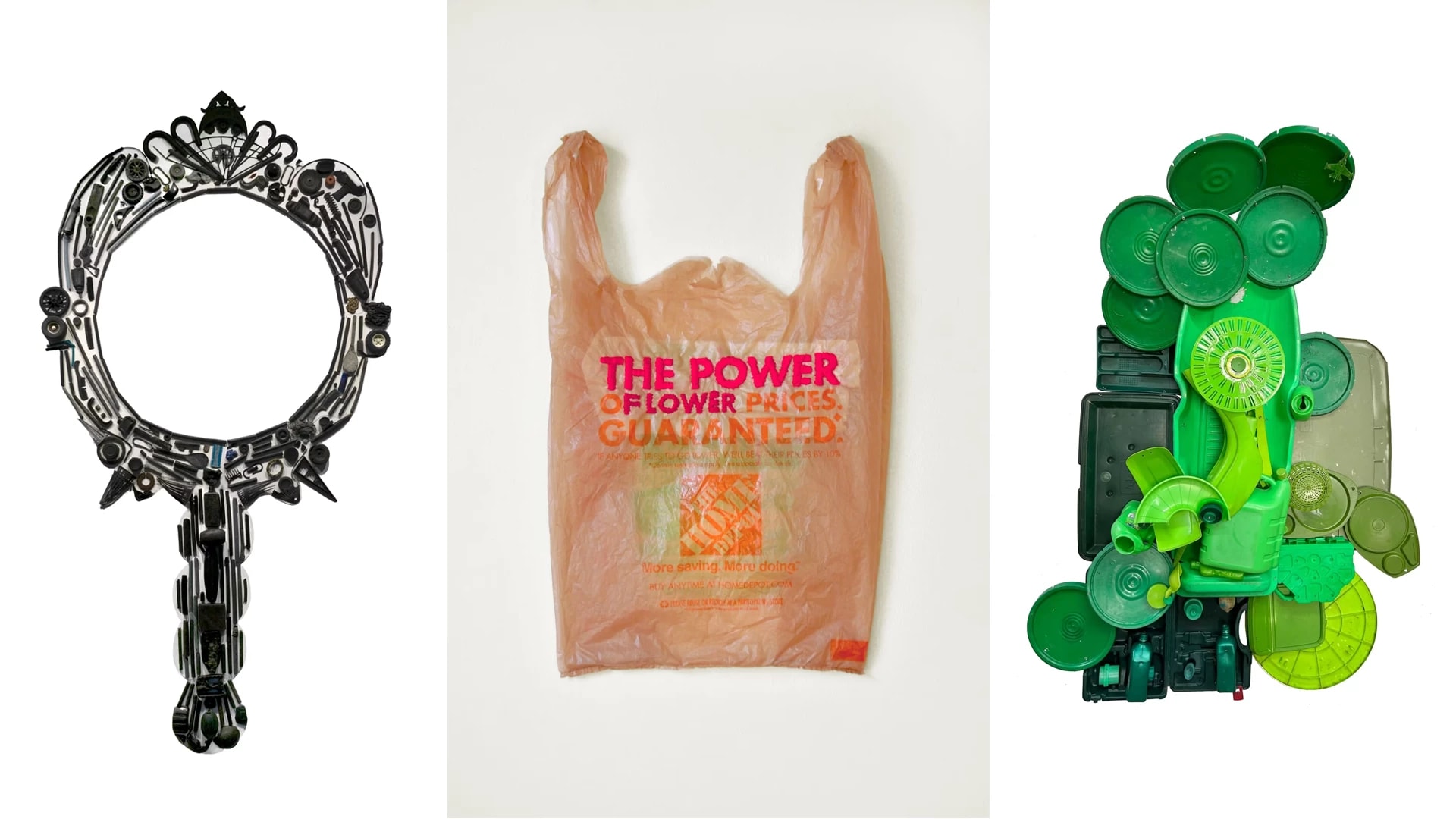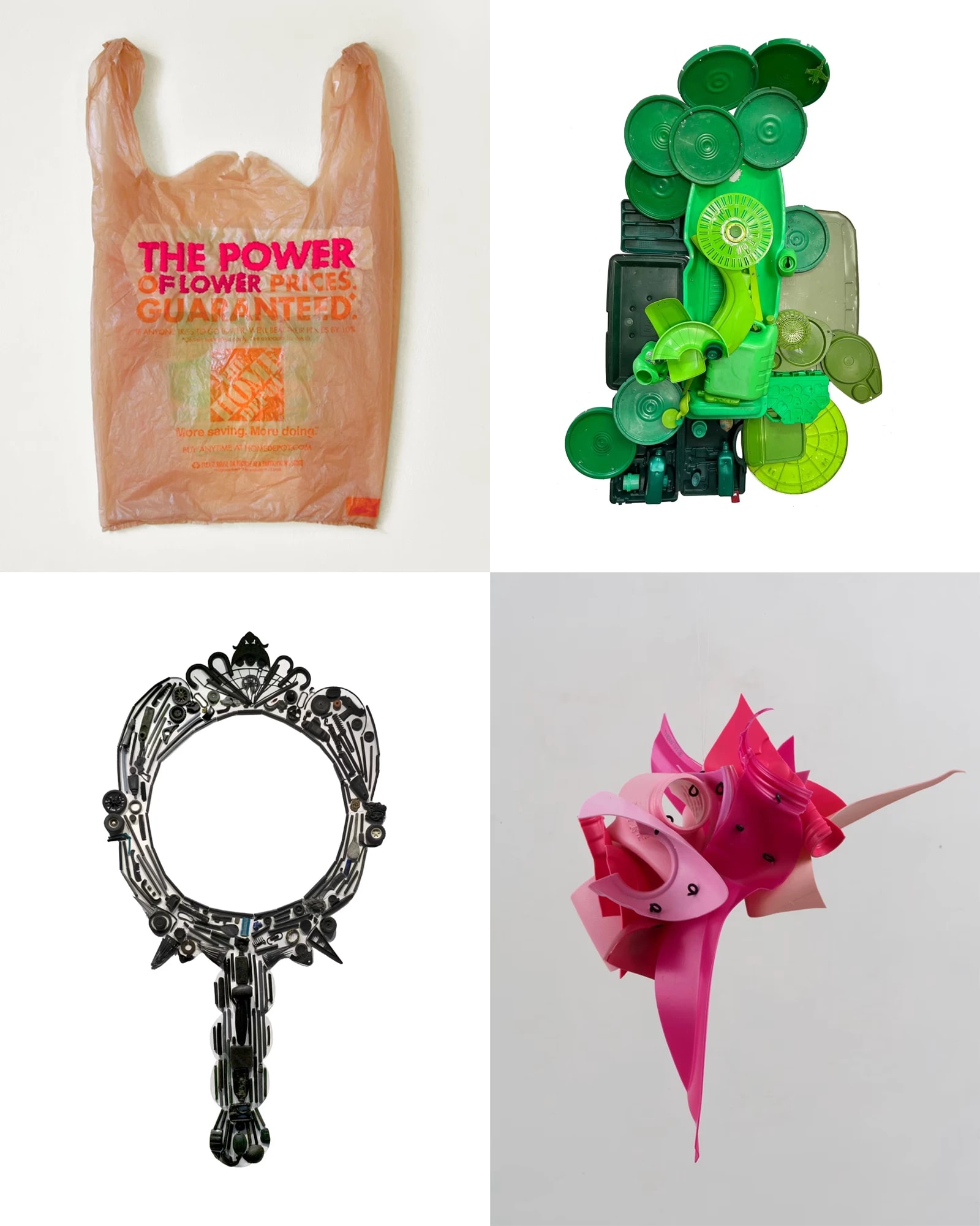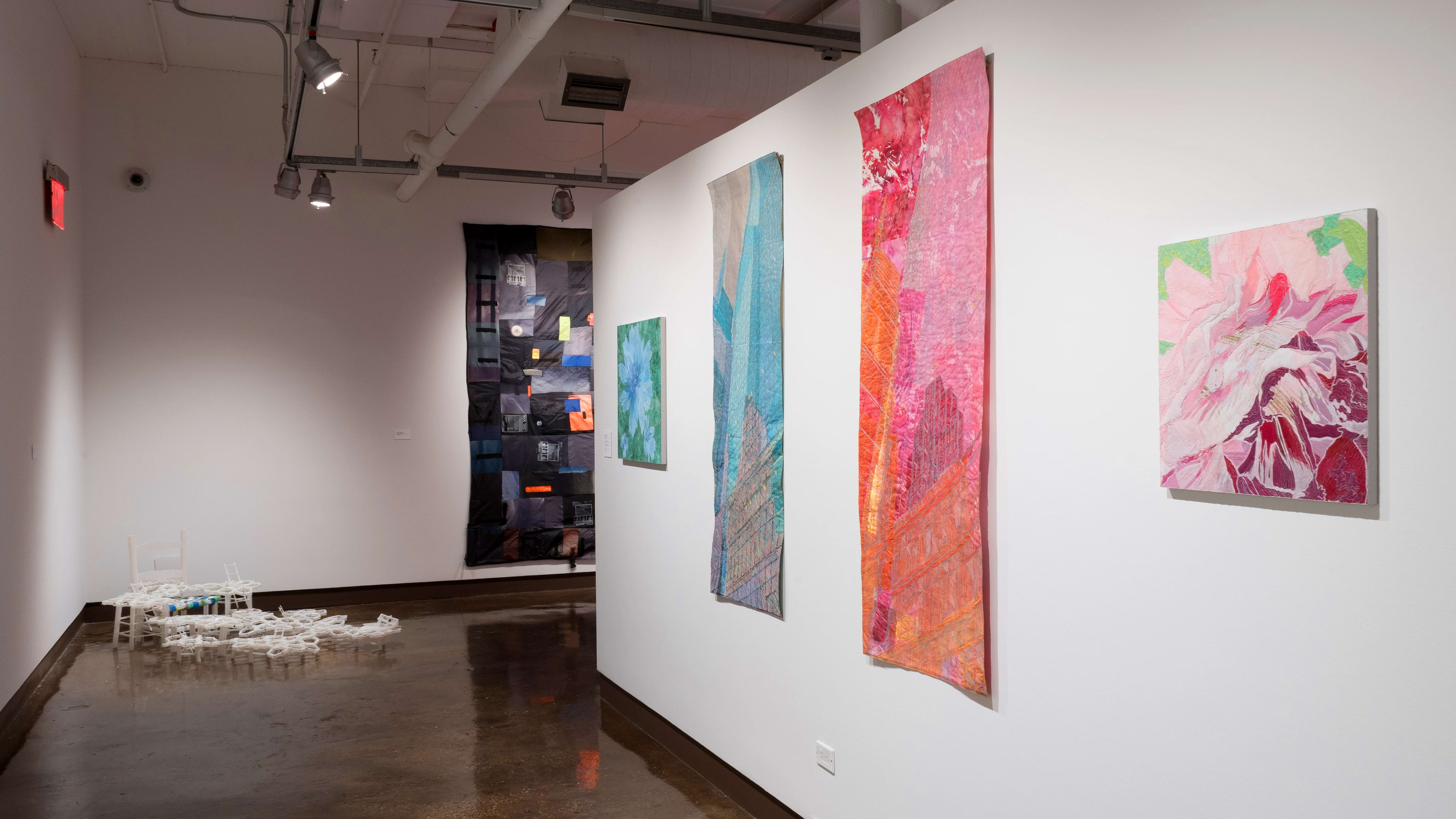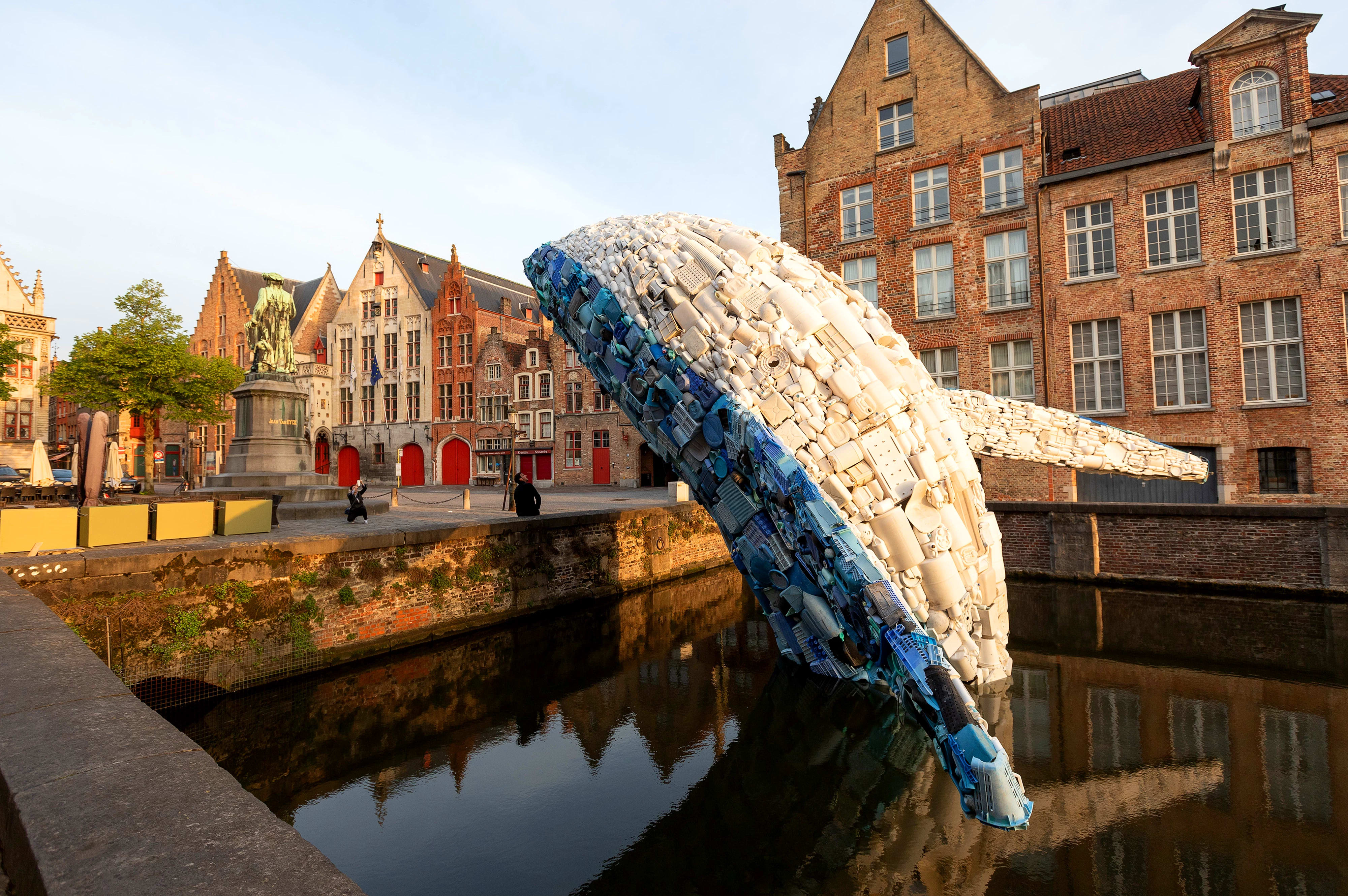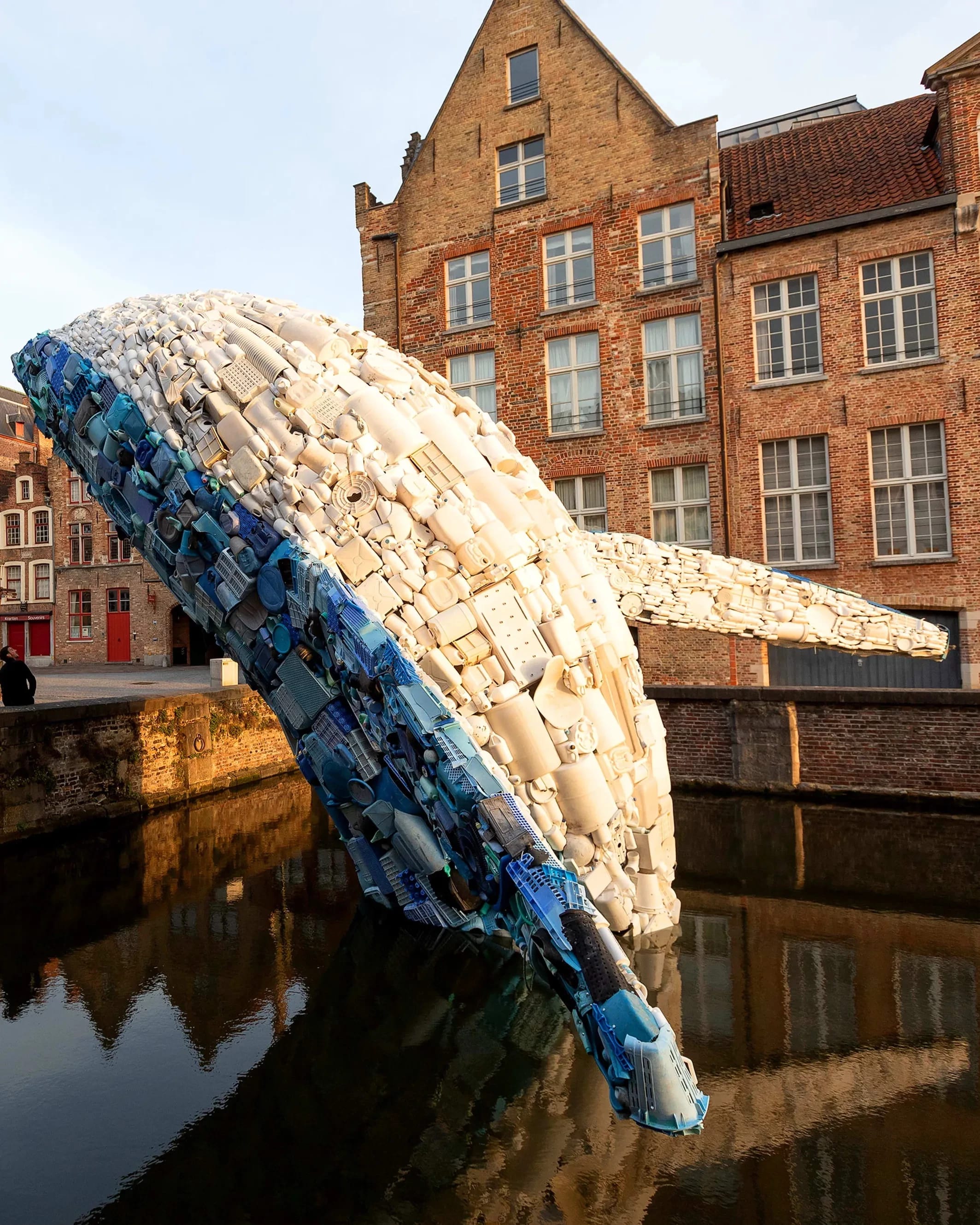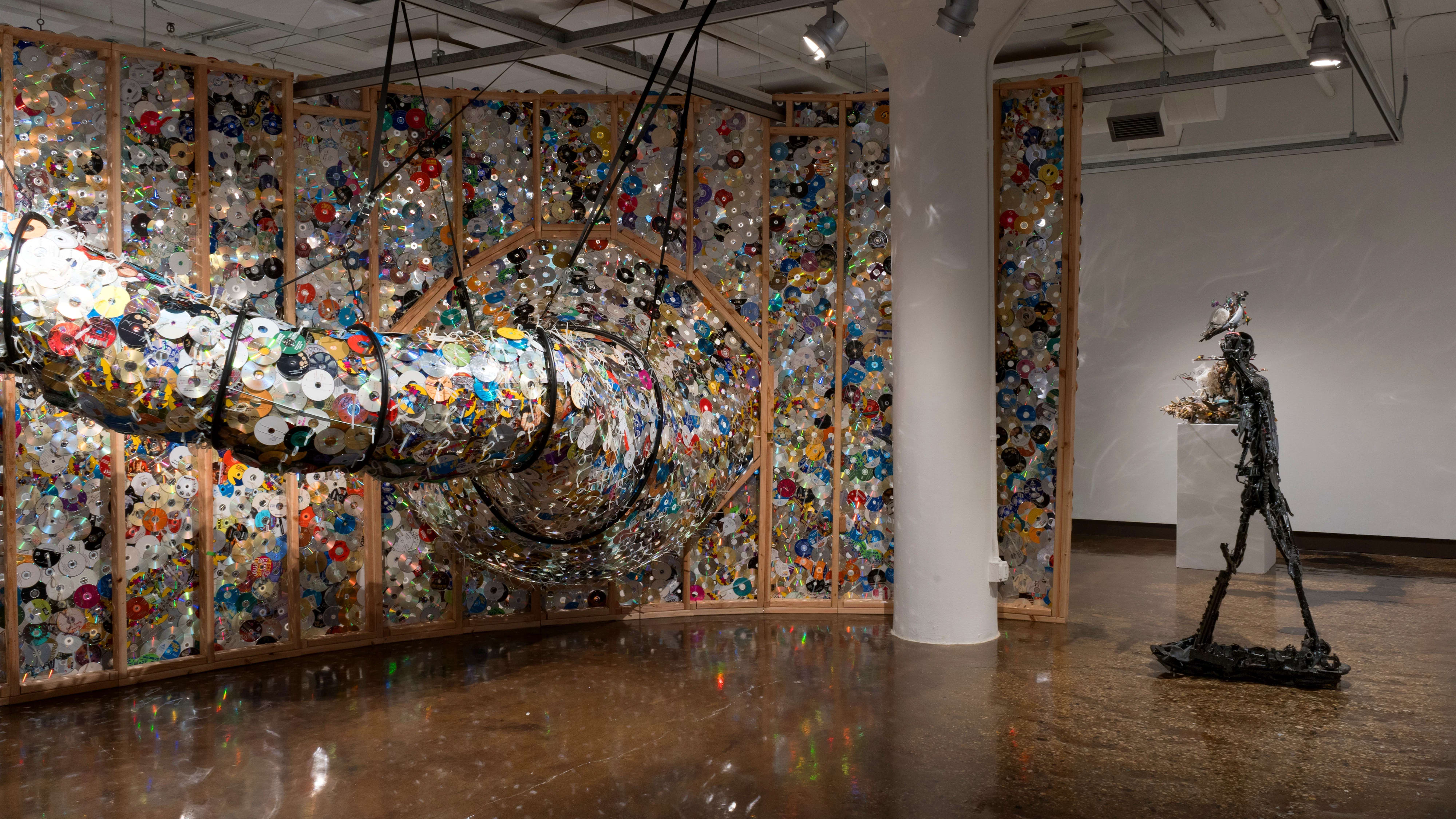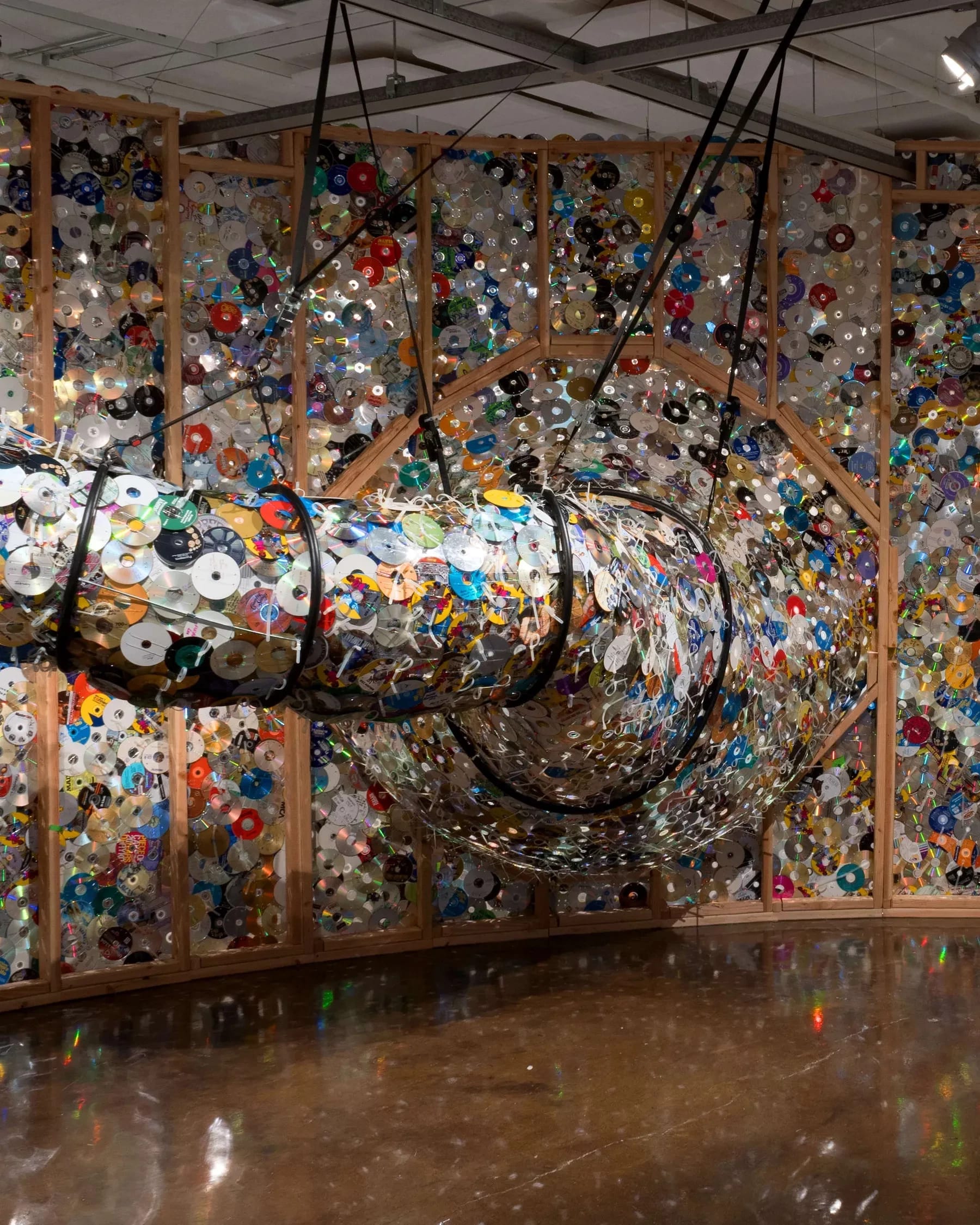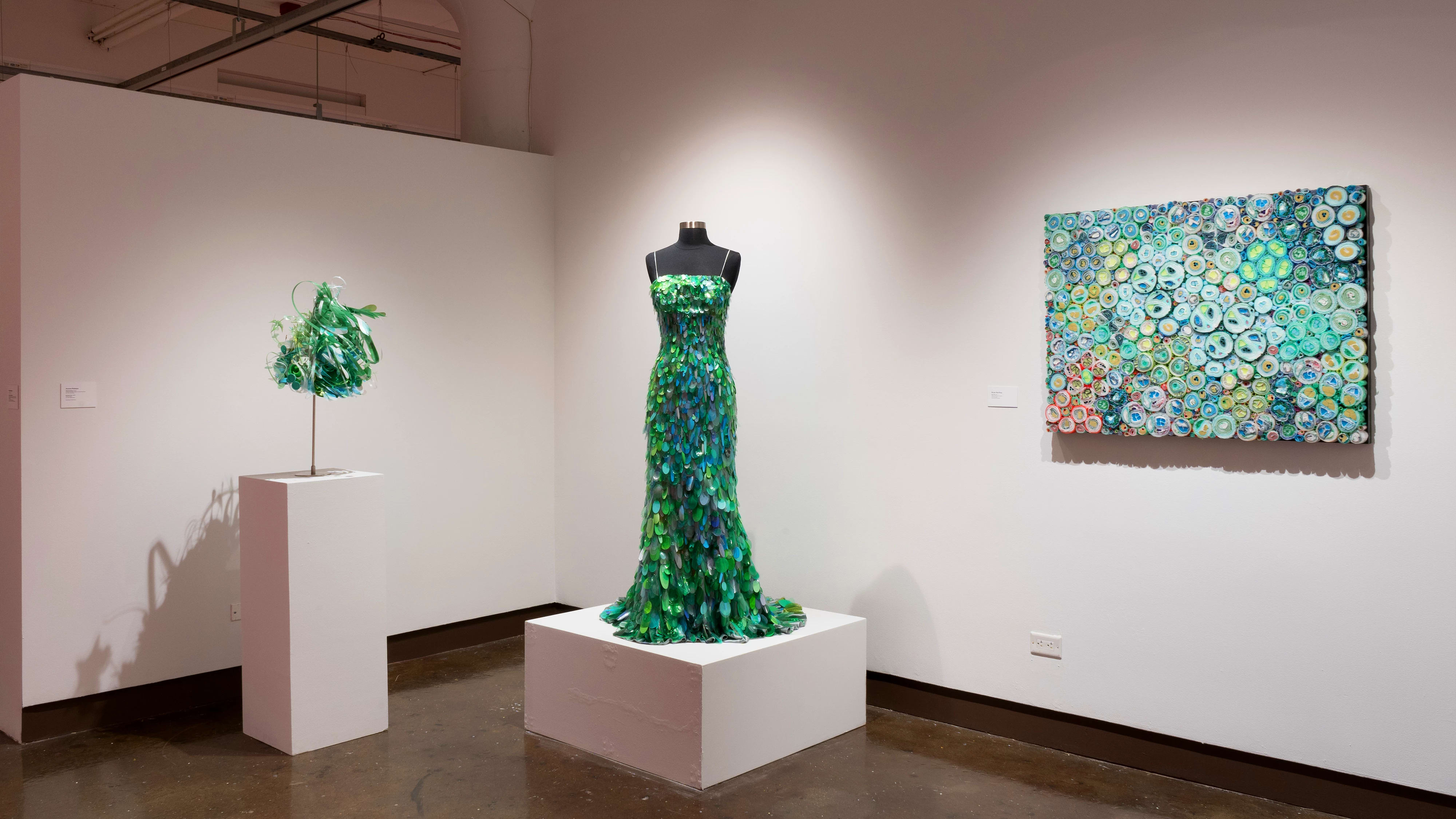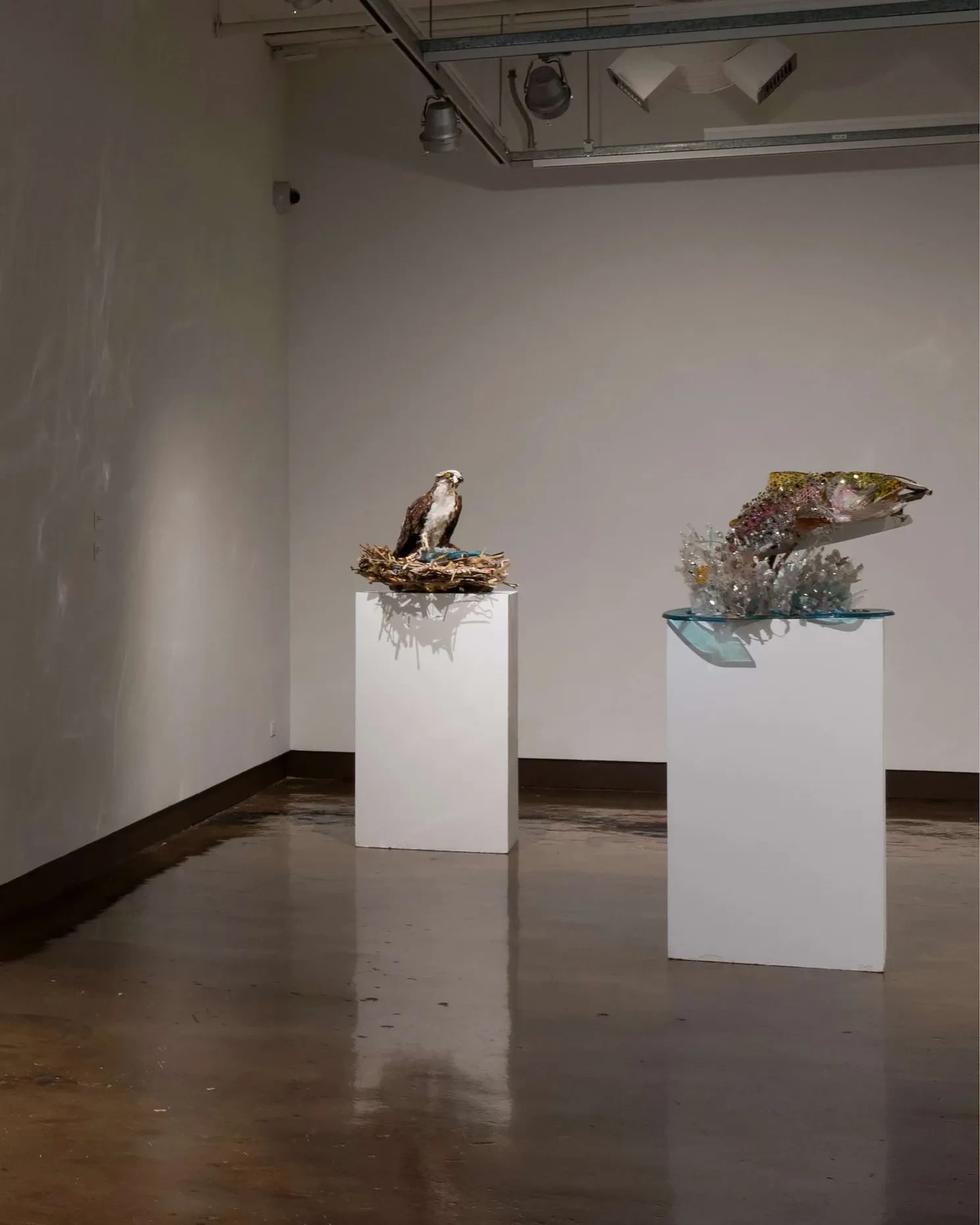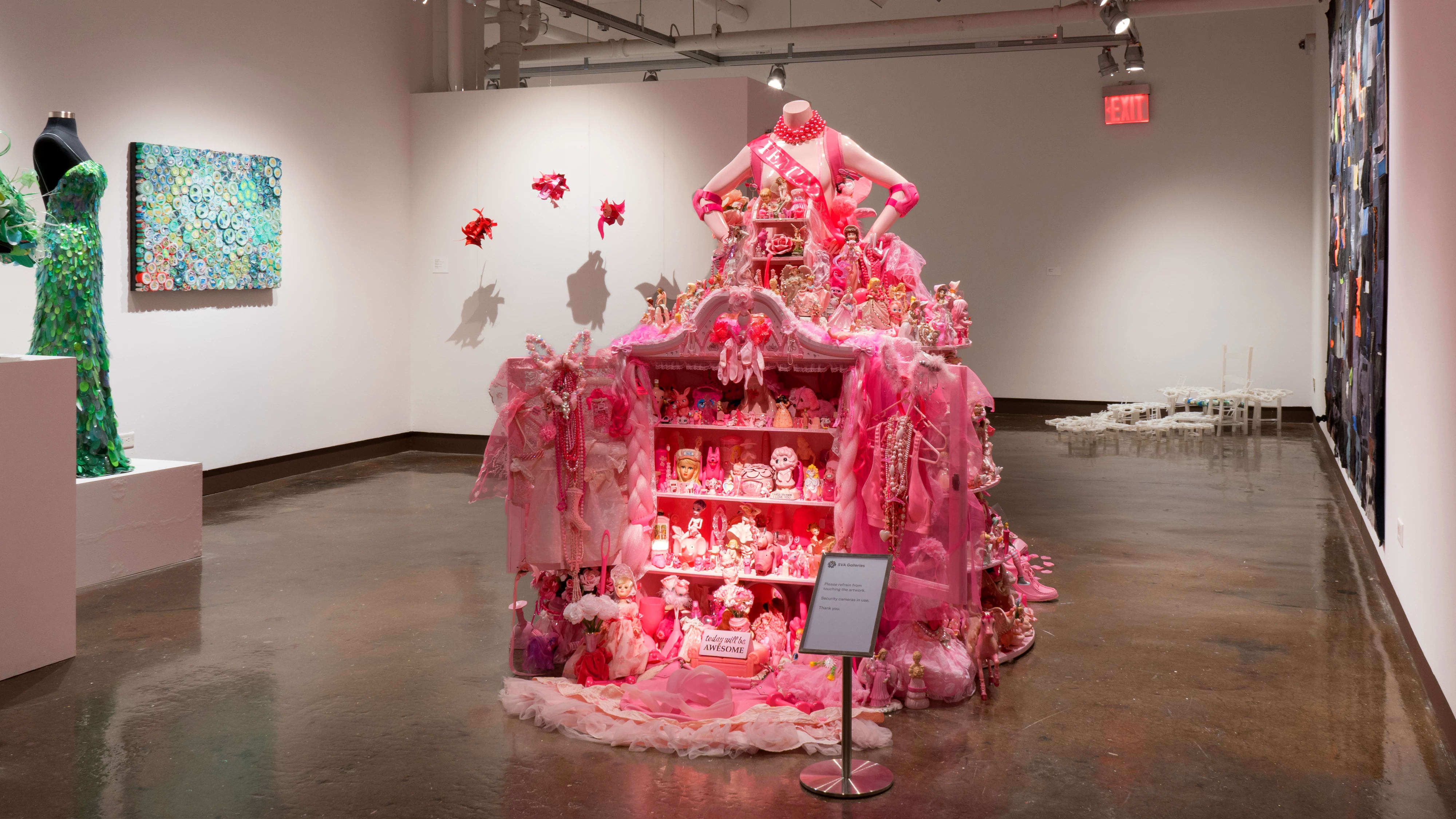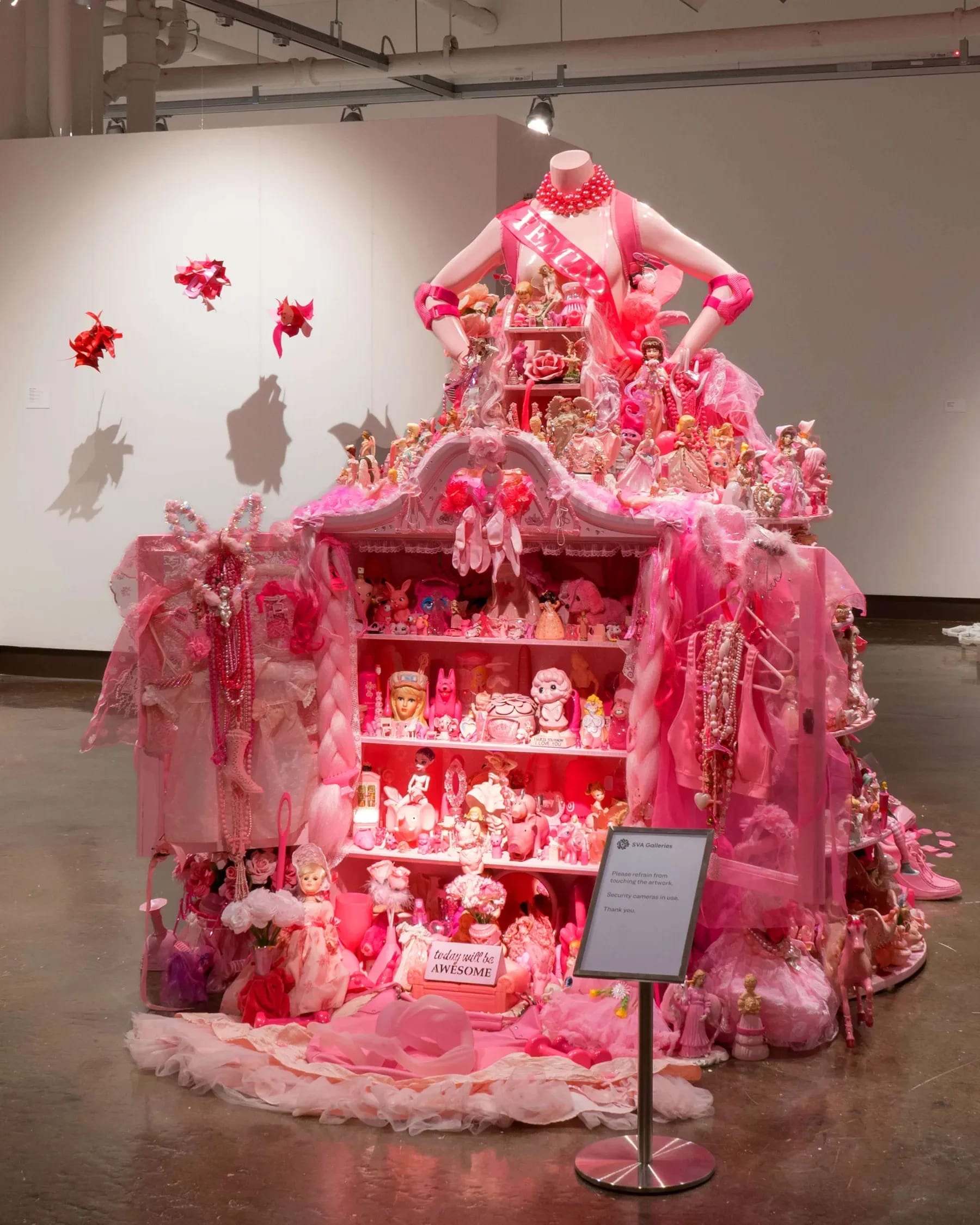The artists discuss the processes, creative techniques, and sustainability practices behind the works currently on view at the SVA Chelsea Gallery.
Left: Pam Longobardi, Sappho’s Mirror I, 2010, found ocean plastic from South Point, Hawaii, 96 x 50 x 4 inches. Center: Kristyna and Marek Milde, Igeology, 2012-ongoing, hand-embroidered plastic shopping bag and silk, 22 x 12 x 4 inches. Right: Tyrome Tripoli, Green Mitochondria, 2024, plastic and metal hardware, 69 x 69 x 11 inches. Courtesy of the artists.
Left: Pam Longobardi, Sappho’s Mirror I, 2010, found ocean plastic from South Point, Hawaii, 96 x 50 x 4 inches. Center: Kristyna and Marek Milde, Igeology, 2012-ongoing, hand-embroidered plastic shopping bag and silk, 22 x 12 x 4 inches. Right: Tyrome Tripoli, Green Mitochondria, 2024, plastic and metal hardware, 69 x 69 x 11 inches. Courtesy of the artists.
Where do your old favorite CDs, plastic toys, and knick-knacks go to die? Or the countless plastic “Thank You” bags and containers from your late-night takeout orders? “Plasticulture: The Rise of Sustainable Practices with Polymers,” on view through December 7 at the SVA Chelsea Gallery, aims to explore these questions through nearly 50 works by 15 artists in the Project Vortex collective. Curated by collective founding artist Aurora Robson, “Plasticulture” inspires a rethinking and reinvention of plastic debris through creative manipulation in the forms of sculpture, photography, textile and fiber art. Below, six of the exhibiting artists, including Robson, reflect on their unique techniques working with unconventional materials, and all the ways artists can prioritize environmental responsibility in the pieces they create.
Natalya Khorover on her work, which uses reclaimed materials destined for landfills, and involves collage and sewing: “The pieces selected for this exhibition are all stitched from soft single-use plastic packaging, the kind you find wrapped around the paper towels you buy at the supermarket, the kind your frozen vegetables come in, and the ubiquitous plastic shopping bags. I find these materials frequently in my own home or from well-meaning friends, [then] dissect the packaging, sort by color and quality, and layer and stitch into 2D artworks inspired by nature or architecture. I use a sewing machine to stitch them together and frequently use a technique called thread painting, which is essentially drawing and painting with needle and thread.”
On how artists can be more sustainable in their practice: “One of the less obvious ways artists can improve their sustainability practices in the studio is to try and reuse and repurpose as many things as possible for their materials and tools, and to bring in as little plastic as possible. Being careful about what you purchase for your art practice and what it comes wrapped in is one of the keys to a sustainable art practice.”
On what she wishes people knew about sustainability: “Every little bit matters. Whatever it is that you can do to help keep this planet cleaner, it all adds up. Also, do not forget to vote! Because legislating for a cleaner planet is super important as well. We need strong laws to keep the big polluting corporations accountable.”
STUDIOKCA‚ Skyscraper (the Bruges Whale)‚ 2018‚ print on Sintra with brace‚ 24 x 36 inches. Photo by Matthias Desmet. Courtesy of the artist and SVA Galleries.
STUDIOKCA‚ Skyscraper (the Bruges Whale)‚ 2018‚ print on Sintra with brace‚ 24 x 36 inches. Photo by Matthias Desmet. Courtesy of the artist and SVA Galleries.
Jason Klimoski (one half of STUDIOKCA with partner Lesley Chang) on his work, which ranges in scale and complexity from lighting fixtures and interior environments to large-scale public installations and pavilions: “In our work with plastic, we are always surprised at the sheer volume of plastic waste in our cities and waterways. Skyscraper (The Bruges Whale), is made from five tons of plastic waste we pulled out of the Pacific Ocean, which allowed us to fashion the whale-shaped sculpture that is about 10 meters tall and 11 meters (fin to fin) wide. Even though five tons is a lot of plastic waste, that amount is only a small fraction of the 150 million tons floating out in the ocean right now.”
On how they make the most of materials: “We try to use the waste that comes from working with waste as much as possible. There is a lot of sawing and grinding and cutting, and we try to use the cast-offs again in the piece.”
On what they wish people knew about sustainability: “It's what everyone knows and all too often forgets—choices matter. Don't worry about the person next to you, make a conscious, daily effort to reduce the amount of waste you produce and seek to reuse as much as possible.”
Leticia Bajuyo, Event Horizon‚ 2018‚ donated CD and DVD discs‚ monofilament‚ cable ties‚ ratchet tie-down straps‚ metal‚ wood‚ irrigation tubing‚ hardware‚ lights and air-fresheners‚ approximately 20 x 25 x 60 feet.
Leticia Bajuyo, Event Horizon‚ 2018‚ donated CD and DVD discs‚ monofilament‚ cable ties‚ ratchet tie-down straps‚ metal‚ wood‚ irrigation tubing‚ hardware‚ lights and air-fresheners‚ approximately 20 x 25 x 60 feet.
Leticia Bajuyo on her work, which spans drawings‚ sculptures‚ installations, and public art‚ emphasizing crafted materiality‚ collected stories, and community engagement: “The primary media in this installation are donated CDs and DVDs. These discs are tied and sewn together with monofilament into strands that are then woven on site onto the wood structure and secured to the wood with hardware. When working on this installation, I came across discs that were donated as early as 15 years ago. Also included in this exhibition are two small sculptures that are made of fragments of discs that broke in past installations. During each installation, I collect all the broken pieces and then hand-cut them into precise elements which are laminated together to create these small sculptures. While building this new installation at the Chelsea Gallery, the CDs and DVDs that broke in the process have been collected to make more of these small pieces.”
On how her work is environmentally responsible: “I often say that the line between sculpting and hoarding is very small. In addition to reusing elements to support sustainability practices, communicating openly about one’s careful and targeted hoarding can also help others in our communities contribute to the collections and keep these items out of landfills.”
On what she wishes people knew about sustainability: “That it matters. Sometimes it can feel like it doesn’t or can’t make a difference in the vast numbers that make up our planet, but doing even a little can have an impact and is better than doing nothing or disregarding the effect each one of us can have.”
Headpiece and dress, left and center. Aurora Robson, Plantpocalypse‚ 2020‚ plastic and paper debris on found hard hat‚ 21 x 19 x 19 inches. Courtesy of SVA Galleries.
Headpiece and dress, left and center. Aurora Robson, Plantpocalypse‚ 2020‚ plastic and paper debris on found hard hat‚ 21 x 19 x 19 inches. Courtesy of SVA Galleries.
Aurora Robson on her work, which focuses on plastic debris as a sculpture medium‚ and developing innovative methods like welding and 3D printing: “For this exhibition, I decided to include a headpiece I made a few years ago that is plastic debris welded to an old construction helmet that my husband found on the side of the road. I created my first dress out of plastic debris as a companion piece for this exhibition. For $5, I purchased an old, stained and ripped synthetic wedding dress from the Salvation Army and eliminated the white synthetic lace exterior so that I could use the inner slip. It was white, so I dyed it greenish gray, then tailored it. After that I hand-cut ovals out of all manner of plastic debris ranging from soda to shampoo bottles, to old motherboard E-waste, and old green bag and tarp materials. The ovals were then hand stitched to cover the dress, essentially like making sequins of varying size, by hand, out of trash.”
On how artists can be more environmentally conscious: “I try to reverse the trajectory of material by taking waste and transforming it into art. Any artist can do this and it is a great way to not only be more sustainable in your studio, but also strengthen your muscles creatively because then you create the value and don’t rely on or perpetuate scarcity economics and the extractive practices that are so destructive to the planet. It is also great to work with your community to alleviate the strain that excess and waste puts on them. I almost always welcome plastic waste materials that are offered to me because it is important to honor the thoughts of individuals with whom your work has come into contact. If it has moved them to the extent that they want to be a part of intercepting a toxic waste stream and transformation/sequestering waste, then you have created some energy or resonance that can continue to move through you in your work and back out again. Also, minimizing the amount of electricity you require to do your work, or if possible using exclusively solar or renewable energy to power the tools you use in your studio, that is a personal aspiration of mine.”
On what she wishes people knew about sustainability: “Researching your materials, where they come from, how they are made, what they are made from, and how far they have to travel to come to your studio is very important and not always obvious. Another thing that is a fun challenge and many artists are doing, is using the scraps from other projects to create other works. Re-using crates, reusing packing materials and avoiding crating whenever possible is also a kindness to the planet.”
Second from right. Tom Deininger‚ Osprey and Pray‚ 2023‚ found materials from landfills and mixed media‚ 28 x 24 x 32 inches. Courtesy of SVA Galleries.
Second from right. Tom Deininger‚ Osprey and Pray‚ 2023‚ found materials from landfills and mixed media‚ 28 x 24 x 32 inches. Courtesy of SVA Galleries.
Tom Deininger on his work, which includes large-scale mosaics and works across various media and styles, addressing consumer culture’s threats to the environment and social values: “I tend to think of my process as a kind of reverse biomimicry in that I look to man-made materials to simulate characteristics of organisms or parts of creatures found in the natural world. Often it’s simply exploiting the potential in the mundane or overlooked. For example, a clear, crushed nip bottle in a parking lot presents itself to me as a part of a bee wing. Maybe a little piece of copper wire works as the substructure vein. So in a sense, the entire practice is like a visual crossword puzzle with the answers scattered randomly across our post-consumer detritus. The catharsis happens when I find an actual use for a worthless scrap. It’s really not a practical solution, but maybe it’s a more poetic one.”
On how artists can reframe their practice to be more conscious: “Sustainability is an interesting topic when it comes to the creation of an artwork in general because so often the artist has an ‘end justifying the means’ approach when chasing a specific vision. I think one of the more interesting aspects of this show is that the means is the endgame. It’s not a solution looking for a problem. The problem is obvious. There will never be a shortage of medium, as long as we’re alive.”
On what he wishes people knew about sustainability: “I wish the general public could understand the magnitude of the problem and that dealing with it becomes more common in our political discourse. Most scientists believe the climate crisis in all of its various forms is among the largest problems ever to face humanity and we seem to be treating it like a little annoyance. I wish that we could see addressing these various problems as challenges that could inspire creativity and unify us to collaborate in global efforts toward a common goal.”
Portia Munson‚ today will be AWESOME‚ 2022‚ found objects‚ synthetic fabric and cloths‚ mannequin‚ salvaged round bar table and a deconstructed secretary desk/cabinet‚ 70 x 64 x 88 inches (size variable). Courtesy of SVA Galleries.
Portia Munson‚ today will be AWESOME‚ 2022‚ found objects‚ synthetic fabric and cloths‚ mannequin‚ salvaged round bar table and a deconstructed secretary desk/cabinet‚ 70 x 64 x 88 inches (size variable). Courtesy of SVA Galleries.
Portia Munson on her installations, sculptures, and digital prints that explore environmental and feminist themes: “My process begins with sourcing objects through a kind of cultural archaeology. I sift through a variety of sites gathering castoffs from yard sales, thrift shops, transfer stations, roadside “free” piles; using salvaged furniture as the structure, organizing and arranging objects around an idea that emerges from the stuff itself. The sculpture today will be AWESOME is made up of found pink figurines, objects, and used synthetic clothing all arranged on repurposed furniture with a mannequin's torso, together making up a large, full-skirted female form, complete with a pink train, a gender color-coded collection of objects that come together to create a female figure, an effigy. This piece investigates female identity and sexuality as dictated through pink ephemeral consumer commodities—all the stuff ‘girls’ ‘need.’ [My] work reflects on how gender, identity, and consumerism intersect and are shaped by the things society tells us we need, then to throw away to buy the next new thing.”
On how artists can be more sustainable in their practice: “Simply be mindful and resourceful with material choices. Amazing art can be made with very simple and sustainable materials.”
On what she wishes more people understood about sustainability: “So much of the essential things we buy like food and water come packaged in plastic. We are basically buying plastic every time we go to the store and buy food. I think it is so important to be aware of this and try not to buy plastic packaging, not to buy water and food in single-use plastic containers.”


